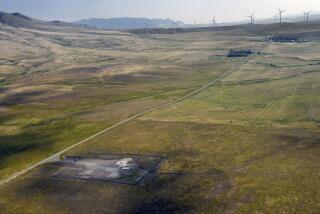Withdrawal Worries Surface In Placid ICBM Silo Country
- Share via
KNOB NOSTER, Mo. — For 30 years, western Missouri farm life has run its course in the bull’s-eye of the Cold War.
Farmers and residents of dozens of small towns have gone about their lives above an arsenal of underground nuclear missiles, sharing this gentle hill country with 150 poised Minuteman II ICBMs. They have lived in the shadow of an anticipated Soviet strike that never occurred.
Now the Air Force, under orders from President Bush to reduce its stockpile of nuclear weapons, is preparing to pull up the missiles. The underground launching silos are scattered across 5,300 square miles on more than 300 farms in a “missile field” near Whiteman Air Force Base here.
With the deactivation project expected to begin next fall, people are wondering how the land and their livelihoods will be affected. Some farmers worry that the emptied silos--which the Air Force hopes to sell them (at so-far undetermined “fair market value”)--will be filled with toxic waste from the missile equipment. Old-timers with limited faith in men and machinery have warned that to extract the nuclear warheads will be to flirt with catastrophe.
“I’m sure they’ll handle it right,” said M. L. Anson, 70, whose fields abut one missile site near the town of Higginsville. “At least, I hope so.”
The plan to scrap the Minuteman II ICBMs and the 351st Missile Wing at Whiteman was announced by the Air Force last fall. The silos were built in 1962 for Minuteman I missiles, and upgraded for the Minuteman II in 1966.
Deactivation of Minuteman IIs (which have a range of 6,300 miles and travel up to 15,000 m.p.h.) began recently near Malmstrom Air Force Base in Montana and Ellsworth Air Force Base in South Dakota--sparsely populated areas where officials say they can hone missile-removal skills.
This area, about 65 miles east of Kansas City, is home to about 100,000 people. At recent Air Force hearings in Knob Noster, a handful of farmers, townsfolk and peace activists voiced concerns about the missile removal project, expected to take three years.
“Farmers like to think of themselves as patriotic,” said Lynn Cheatum, a peace activist who once owned a missile-site farm. “But if (the Air Force) doesn’t do what’s respectful to the land, those farmers will not be happy.”
Air Force officials say the farmers will be heard.
“We’re going to go out and talk to the farmers and say, ‘This is what we’re going to do. Do you see any problems?’ ” said Capt. Matt Durham, public relations chief at Whiteman.
There also was worry that deactivation would ruin local economies. That issue seemed to be settled when the Air Force announced plans to use Whiteman as home base for the B-2 Stealth bomber. The matter awaits approval in the Defense Department budget.
And what about the danger of an explosion? An environmental report concluded it was “infinitesimal.” It was good news to farmer James Houx, who said the armed missile guards made life interesting and scared off trespassers.
“I have nothing but good things to say about our rapport with the Air Force and the missiles,” Houx said. “They’ve been very good neighbors, and we’ll miss them.”
More to Read
Sign up for Essential California
The most important California stories and recommendations in your inbox every morning.
You may occasionally receive promotional content from the Los Angeles Times.









